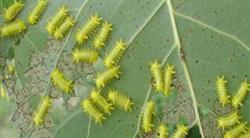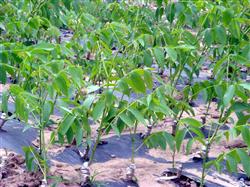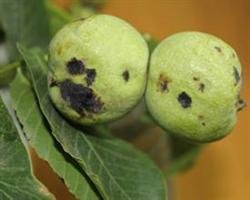Scientific planting techniques of walnut seedlings and walnut trees

Walnut seedlings, walnut trees, grafted walnut seedlings, crop-grafted walnut trees planting, understanding, consultation, investigation and purchase to Sichuan pine agriculture! Cultivation techniques of high quality, high yield and high yield: 1. Soil preparation: choose the open hilly and flat land with deep soil layer, soil thickness more than 100cm, slope below 25 °and soil pH value of 7-7.5. Dig a planting ditch with a width of 1 meter and a depth of 1 meter. After digging the ditch, apply fully mature organic fertilizer 5000 kg or press into the straw 6000 kg. After the fertilizer is fully mixed with the topsoil, it is backfilled into the ditch from top to bottom. two。 Seedling selection: choose 2-year-old high-quality grafted seedlings with good healing interface, strong growth, complete and developed root system, no diseases and insect pests and mechanical damage, and more than 1 meter high. The roots should be trimmed before planting, and the excessively long roots, split roots, damaged roots and rotten roots of the seedlings should be cut off to reveal new stubble. The seedlings must be soaked in water for more than 12 hours before planting, so that the seedlings can fully absorb water to facilitate the germination and rooting of the seedlings. 3. Planting time: either in spring or in autumn. Planted in spring from the Spring Equinox to Qingming (from late March to early April), the planting depth is based on the depth of covering soil when the seedlings are in the nursery. Autumn planting is carried out in the middle and last ten days of October. Before the soil is frozen, the autumn tree trunk will be lying down to cultivate the soil. The soil thickness is not less than 20 cm from the tree trunk. 4. Planting density: Xiangling is a precocious walnut, with 56 plants planted in 667 square meters, that is, 3 meters × 4 meters. In the early stage of the garden (within 5 years), it can be intercropped with peanuts, legumes, potatoes and dwarf crops such as shallow-rooted traditional Chinese medicine, strawberries or green manure. Intercropping is generally not suitable after 5 years. No matter what kind of crop is intercropped, it should be more than 1.5 meters away from the trunk. 5. Soil fertilizer and water management: ① ploughing and weeding. When young trees are young, weeds must be weeded in time to prevent weeds from competing with trees for water, fertilizer and glory. It can also improve soil permeability and promote tree growth. Deep ploughing and pressing green fertilizer or applying organic fertilizer was carried out in spring, summer and autumn, before sprouting in spring and after rain in summer and autumn, and weeds were buried in the soil combined with fertilization. Deep ploughing should be carried out from the planting hole year by year, with a depth of 60 cm to 80 cm, and do not damage the thick roots with a diameter of more than 1 cm. ② fertilized rationally. Deep ploughing is carried out in combination with base fertilizer every autumn, with a depth of 30cm to 50cm. When applying base fertilizer, the amount of fertilizer is 667 square meters, 4000kg and 5000kg, and a small amount of available nitrogen and phosphorus fertilizer is added. Topdressing was applied three times a year, urea 30kg was applied to 667 square meters before germination, and potassium sulfate or special fertilizer for fruit trees was applied at the stage of young fruit expansion and hard seed, respectively. In order to promote its growth, foliar fertilizer should be sprayed at the same time as topdressing, the first time in mid-late April, the second time in mid-May, the urea sprayed 300 times, the third time 200 times, and the fourth time 200 times urea + 300 times potassium dihydrogen phosphate in early August. ③ is watered at the right time. Generally, water is watered four times a year, before sprouting, fruit expansion, hard core stage and before freezing. Walnut is a deep-rooted tree species, drought resistance is not resistant to waterlogging, the rainy season should pay attention to timely drainage, do not let water in the garden for too long, otherwise it will cause rotten roots or dead trees. 6. Flower and fruit management: ① sparse male. The number of male flowers of walnut is very large, and excessive growth of male inflorescences consumes a lot of nutrients of the tree. Therefore, flower thinning is carried out 7-10 days before male flower bud germination, 90%-95% of male flowers are thinned, and the ratio of male flowers to female flowers is 1 ∶ 25-1 ∶ 40, which can save a lot of nutrition and water, which can be used for female flower development and fruit growth, so as to achieve the purpose of increasing production. ② artificial pollination: collect the male inflorescence to be pollinated, put it in the dry room and dry it in the shade. Under the condition of 20-25 ℃, the pollen can be dispersed after 24-48 hours, and then the pollen is collected and prepared. When the female flower stigma is dehiscent and inverted eight-shaped, the stigma protrudes, secretes a lot of mucus, and has a certain luster is the best time for pollination, pollination is best when pollen and flour are mixed in a ratio of 1 ∶ 10 or 5000 times liquid, and it is best to pollinate on a sunny day without dew. In general, at 9: 11 am and 15: 17 pm, the amount of pollination should not be too large, because the female flower of walnut is sensitive to a large number of pollen. 7. Plastic pruning: as the walnut leaves begin the bleeding period, pruning should be carried out after the walnut harvest to before the beginning of the defoliation. Xiangling belongs to early fruiting walnut, which has strong branching power, early fruit, easy to produce secondary branches, resulting in tree shape disorder, and often uses open stratification and natural happy tree shape. When pruning, we should not only pay attention to cultivating the main and lateral branches, but also control the secondary branches and overgrown branches in time, remove the dense branches and deal with the inferior branches. In the fruiting period, the tree paid attention to the renewal and rejuvenation of the fruiting branch group, using the method of removing the weak and retaining the strong, reducing and shrinking to renew the branch group, and at the same time remove dry and withered branches, disease and insect branches, overlapping branches and weak branches. 8. Pest control: the main diseases and insect pests of Xiangling walnut are anthracnose, black spot, canker, longicorn beetle, diamondback moth, wing moth and so on. Timely prevention and control should be carried out. 9. Timely harvest: when the green skin of walnut changes from green to yellow and cracking, it can be harvested generally from late September, when there is an opening of more than 1x3 in the tree, hit down and pick it up with bamboo pole from inside to outside. The method of desquamation is to dip the green walnut in 2000 times ethephon solution for half a minute, remove it and pile it into a pile 50 cm thick, cover it with plastic sheeting, and peel off in 3 to 5 days. During this period, the walnut should be turned frequently to dissipate heat, and the walnut without green skin should be washed with clean water immediately. When drying, do not expose yourself to the sun to avoid skin cracking and deterioration of walnut kernels. Pack and store them in time after drying.
- Prev

What if the walnut tree doesn't hang its fruit?
Grafting type grafting seedlings are grafted on rootstock seedlings (seedlings) to graft new walnut seedlings. There are mainly two types: tongue grafting and bud grafting. 1. Tongue grafting is divided into two types: skin-inserted tongue grafting and double-tongue grafting. 2, bud grafting is divided into seed bud walnut seedling grafting and square bud grafting. Square bud grafting is the most commonly used walnut seedling marriage at present.
- Next

Measures for control of black spot of walnut
The pathogen of walnut black spot generally overwinters in shoots or buds, and the bacterial liquid secreted by Yanchun mainly harms young fruits, leaves and twigs by wind and rain. Management methods: 1. Overwintering management. After deciduous leaves, tree trunks and branches are smeared to protect the general from spreading germs on the tree, heat preservation, disinfection and frost prevention. Spray tree protection at the same time.
Related
- Moge, come on! The staff of the peasant association in the producing area of cantaloupe were frightened when the crowd gathered.
- Causes and Solutions of low Fruit setting rate of Apple
- Symptoms and control measures of passion fruit virus disease
- Fruit growing lesson: how do apple orchards keep high yields?
- Can you build orchards in the mountains? What are the pros and cons?
- How to manage the coloring period of Crisson grape?
- This paper introduces the processing technology of two kinds of fig products.
- How much is a month for retired teachers in rural areas by 2020?
- How can strawberry planting increase sugar content? We should pay attention to management in many aspects.
- What are the cultivation techniques on how to improve the yield of golden fruit?

